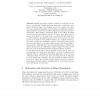Free Online Productivity Tools
i2Speak
i2Symbol
i2OCR
iTex2Img
iWeb2Print
iWeb2Shot
i2Type
iPdf2Split
iPdf2Merge
i2Bopomofo
i2Arabic
i2Style
i2Image
i2PDF
iLatex2Rtf
Sci2ools
DGCI
2003
Springer
2003
Springer
Shape Similarity and Visual Parts
Abstract. Human perception of shape is based on visual parts of objects to a point that a single, significant visual part is sufficient to recognize the whole object. For example, if you see a hand in the door, you expect a human behind the door. Therefore, a cognitively motivated shape similarity measure for recognition applications should be based on visual parts. This cognitive assumption leads to two related problems of scale selection and subpart selection. To find a given query part Q as part of an object C, Q needs to have a correct size with regards to C (scale selection). Assuming that the correct size is selected, the part Q must be compared to all possible subparts of C (subpart selection). For global, contour-based similarity measures, scaling the whole contour curves of both objects to the same length usually solves the problem of scale selection. Although this is not an optimal solution, it works if the whole contour curves are ’sufficiently’ similar. Subpart select...
| Added | 06 Jul 2010 |
| Updated | 06 Jul 2010 |
| Type | Conference |
| Year | 2003 |
| Where | DGCI |
| Authors | Longin Jan Latecki, Rolf Lakämper, Diedrich Wolter |
Comments (0)

